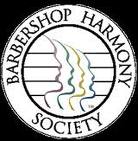|



Listen To Us
E-Mail Us

Call Us
(866) 727-4988 |
 About Barbershop Harmony About Barbershop Harmony
What is
Barbershop?
Origin
-
During the
1920s in the USA, men waiting for a haircut would sing together for their
own entertainment, making up their harmonies as they went along (we call
this "woodshedding" now) and, after a time, developed their ability to
harmonize to the popular songs of the day. Contest rules prohibit the use
of musical instruments other than to take pitch. There are now thousands
of barbershop singers round the world.
The Four
Parts
-
The four
parts are called Tenor, Lead, Baritone and Bass. The melody is usually
sung by the lead because he takes the lead and the others "follow", or
"fit in" with this lead.
The Tenor harmonizes above the melody. In
the men's groups the tenor is sung in falsetto to avoid drowning out the
lead. The listener's ear normally hears the highest note most easily, so
that is why normally male and female groups are separate. Some mixed
groups exist, but it is very difficult to prevent the high female voices
drowning out the lower male voices.
The Bass sings the lowest
harmonizing notes below the melody. The base forms the foundation for the
chord structure.
The Baritone completes the chord, usually below
the melody, but can be above it for a few bars at a time.
The
melody may be sung occasionally by the Bass, but not by the tenor except
for an infrequent few notes to avoid awkward voice leading, and in
introductions or tags.
The Chord
Structure
-
Major and
minor chords are used, and at least a third of the chords should be
dominant seventh chords, resolving primarily on the circle of fifths.
Sixth, ninth and major seventh chords are avoided except where demanded by
the melody, while chords containing the minor second interval are not used
at all. The basic harmonization may be embellished with additional chord
progressions to provide harmonic interest and rhythmic momentum, to carry
over between phrases, or to introduce or close the song effectively.
Pitch
-
The human
voice has the advantage that the notes are not fixed pitch like a piano.
The piano tuner sets the pitch of each note, to a compromise value. This
means that the piano can never play a perfectly tuned chord - it is always
a compromise chord. Barbershop singing tries to tune every chord perfectly
in relation to the note sung by the Lead, each part adjusting to match the
note sung by the lead. When this is successful a fifth note can be heard,
that no-one is singing, soaring above the rest. This fifth note is formed
by perfectly matched harmonics and the sound is called a "ringing chord".
The
Director
-
Barbershop
music is always memorized. This means that every singer can watch the
director, and has his or her hands free for gestures. The Director takes
wide liberties with note values, and uses tempo and volume changes to
create a mood and tell the story more effectively.
Enhanced
Sound
-
Amplification is not needed as a general rule. When
everyone in a quartet matches pitch and vowel sound perfectly, they sound
much louder than they are actually singing, and they can easily be heard
by a hundred people. A larger chorus can fill an auditorium with sound,
and amplification is only needed for the announcer who introduces the
songs.
|